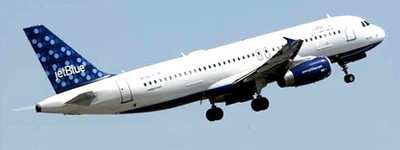FDR Indicates The Brakes Were Engaged During Approach
 If you've ever tried to drive your
car with the parking brake engaged, you have an idea what was going
on when a JetBlue A320 landed on August 26th in Sacremento
resulting in a tire blowout and small fire. The NTSB says in its
preliminary report that, according to the aircraft's flight data
recorder, the brakes on the main gear were engaged during final
approach.
If you've ever tried to drive your
car with the parking brake engaged, you have an idea what was going
on when a JetBlue A320 landed on August 26th in Sacremento
resulting in a tire blowout and small fire. The NTSB says in its
preliminary report that, according to the aircraft's flight data
recorder, the brakes on the main gear were engaged during final
approach.
NTSB Identification: WPR10IA430
Scheduled 14 CFR Part 121: Air Carrier operation of JETBLUE AIRWAYS
CORP
Incident occurred Thursday, August 26, 2010 in Sacramento, CA
Aircraft: AIRBUS A320-232, registration: N590JB
Injuries: 7 Minor, 84 Uninjured.
This is preliminary information, subject to change, and may
contain errors. Any errors in this report will be corrected when
the final report has been completed.
On August 26, 2010, at 1251 PDT, an Airbus A320-232, N590JB,
operated by JetBlue Airways Corporation as flight #262, landed at
Sacramento International Airport, Sacramento, California. During
touchdown on runway 16R, the airplane rapidly decelerated, the main
landing gear tires blew out, and a minor tire-related fire erupted.
All of the occupants in the airplane evacuated via the emergency
egress cabin door slides. The airplane sustained minor damage, and
7 of the 86 passengers received minor injuries during the
evacuation process. None of the 2 pilots or 3 flight attendants
were injured. Visual meteorological conditions prevailed at the
time of the scheduled, 14 Code of Federal Regulations (CFR) Part
121 domestic passenger flight, which originated from Long Beach,
California, at 1141.
According to the flight crew, the flight and approach to runway
16R were normal. The first officer was the flying pilot. On
touchdown, the airplane began a rapid deceleration, and the first
officer remarked to the captain that it felt like a main landing
gear tire blew out. About this time, air traffic control tower
personnel reported observing sparks and smoke in the area of the
main landing gear. The captain took control of the airplane. He
maintained directional control, and the airplane came to a stop
about 2,000 feet from the touchdown point. The captain directed the
first officer to initiate the ground evacuation Quick Reference
Checklist up to the evacuation decision point. At that time, air
traffic control tower personnel confirmed smoke and fire was still
visible around the main landing gear. Based on this information the
captain elected to evacuate the airplane. Crash fire rescue
personnel and equipment responded to the airplane, which had
stopped on the runway. According to the flight crew and flight
attendants, a swift and orderly evacuation was performed via
emergency evacuation slides at the L1, R1, and L2 doors.

File Photo
The airplane was subsequently examined by the operator and FA
personnel. Airplane damage was limited to four deflated main
landing gear tires and ground down wheel rims. The main landing
gear tires showed evidence of being locked on touchdown. Ground
damage was limited to minor grazing to the runway's surface.
According to airplane recorded flight data, the parking brake
had become engaged during the landing approach approximately 5,100
feet mean sea level, and it remained engaged throughout the
landing. During interviews with the flight crew, neither pilot
recalled any abnormal indications or warnings associated with the
braking system prior to landing.
 ANN's Daily Aero-Term (04.26.24): DETRESFA (Distress Phrase)
ANN's Daily Aero-Term (04.26.24): DETRESFA (Distress Phrase) ANN's Daily Aero-Linx (04.26.24)
ANN's Daily Aero-Linx (04.26.24) Airborne 04.22.24: Rotor X Worsens, Airport Fees 4 FNB?, USMC Drone Pilot
Airborne 04.22.24: Rotor X Worsens, Airport Fees 4 FNB?, USMC Drone Pilot Airborne 04.24.24: INTEGRAL E, Elixir USA, M700 RVSM
Airborne 04.24.24: INTEGRAL E, Elixir USA, M700 RVSM Airborne-NextGen 04.23.24: UAVOS UVH 170, magni650 Engine, World eVTOL Directory
Airborne-NextGen 04.23.24: UAVOS UVH 170, magni650 Engine, World eVTOL Directory




